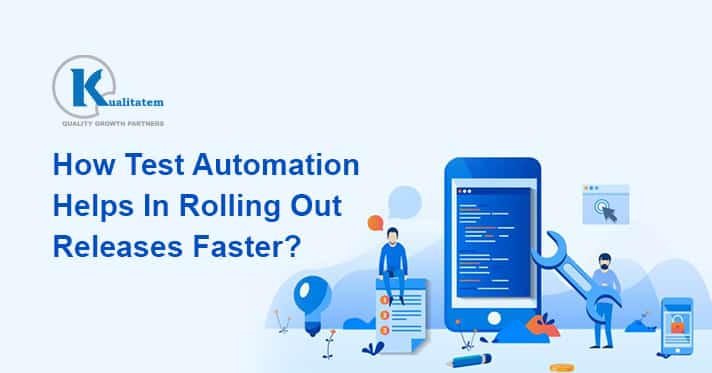How Test Automation Helps in Rolling Out Releases Faster?

- May 21, 2020
- HibaSulaiman
Big companies are often troubled with one simple yet important question: How to reduce defect rate? A very short answer to it would be a well-thought execution plan coupled with automation.
In this article, I will elaborate on this answer, expand on automation, and how it helps to roll out releases faster.
Automation
Automation is on the high. It’s making its way into every industry, minimizing errors and maximizing productivity. It allows organizations to put less effort into repetitive work and save millions of dollars in the process of reliable development and deployment. In software development, an automation testing company allows organizations to trigger a build, deploy it to the test environment, run the test suite, and promote the build to production. If anything goes wrong, necessary remediations can be made and required parties can be proactively notified through monitoring and alerting capabilities.
The following are some of the automation frameworks that are widely used for development, testing, and deployment.
- Pre-Built Software
- Validation and Testing Automation
- CI/CD for Release Control
But first, let’s learn more about frameworks and their importance in automation.
Frameworks
Frameworks are generic functionalities that can be modified and extended to suit the additional requirement of customization. The core engine is pre-built, tested, and upgradable/customizable, thus providing robustness and stability. It provides a standard way to build and deploy automation which reduces project errors. Regular evaluations and upgrades allow development teams to easily implement quality custom-built apps.
- Pre-Built Software
Predicting the cost of a new project is difficult. A pre-built software not only helps you predict costs but also controls them. It addresses the gaps that increase costs and delay releases – such as poor design capabilities and badly-written code.
- Validation and Testing Automation
In simple words, test automation is the mechanization or automation of repetitive but necessary tasks in a formalized testing process already in place. It is critical for continuous testing and continuous testing. While releasing software without testing might appear to be a cheaper option than with testing, an untested software has a greater chance of having critical errors. So, in the long run, the cost of a tested software is always less than the untested one. To ensure a bug-free software, test coverage should be exhaustive and repetitive.
Benefits of Automation Testing
- Early detection of bugs
- Repetitive test scenario with no human involvement
- GUI testing in multiple browsers and platforms increases the defect detection rate
- Continuous testing and API-driven testing exposes bugs in multiple scenarios and releases
- Test repositories ensure desirable test execution and as a result, a bug-free product at each release
- CI/CD for Release Control
CI/CD is an industry-standard that has evolved into release control and build maker. CI was created for Agile development. It organizes development into functional user stories which are put into smaller groups of work or sprints. It fixes issues quickly and provides developers with necessary feedback.
How to Enable Bug-Free Deployment
Build Creation
CI tools check whether an application is free of bugs by running automated tests side-by-side with a few industry-standard tools. This is done for each build creation’s run. Whenever a build fails, the reason for its failure is identified and a report for bug fixing is sent. This helps teams to rectify the code in a shorter time.
Release Management
Successful builds are mapped and versioned to the release. These releases are graduated over a process through various approaches – the most common one is to use development, staging, and production environments for release management. The release repository is a standby solution which is useful in a scenario where the new releases are incompatible for any unmarked reason. Business functioning with quality operations is enabled by a quick rollback.
Continuous Deployment
DevOps has been a revelation that has helped companies control their cost of software development. It has significantly reduced the downtime and breakage time for each release. Overall, it enables quality deployment and the rollback plan is always available in case of any eventuality. Through sets of code, the configuration manager’s role is entirely automated in CD. Whenever a fresh environment is needed and achieved automatically in seconds, infrastructure as a code IAC is used and deployed. System administrators are more confident to have a code deployment and a quality environment. No more rollback nightmares and broken sites during any upscaling or code deployment. This results in downtime reduction and an increase in the happy client index.
Before automation, there were the following steps:
- Changes in file
- FTP to dev path
- Commit to GIT
- Test in staging
- Push to production
- Repeat the process for all changes
After Automation:
An automated pull happens in the DEV path and GIT is linked to the development environment. The only step is to ‘edit’ the file in IDE and ‘save’ – the file will be directly committed in GIT and the functionality through test cases will also be validated.
Automation frameworks combined with manual coding ensure quality project delivery in a shorter time, minimized effort, and optimized cost.











